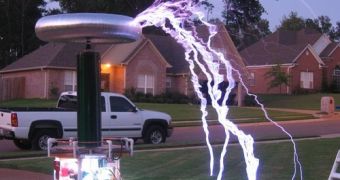The problem of transporting electricity throughout large distances comes from the fact that conducting wires can break, snap in the wind, or when a tree falls on them, so every major storm knocks out most of the power grid, isolating important human communities.
Trying to solve this problem, a team of students at MIT developed a new technique that can transmit power wirelessly to cell phones, laptops, MP3 players, household robots and other electronics. In one sense, the researchers are going where many scientists have gone before: the most famous, Nikola Tesla, tried to set up a power-beaming tower a century ago, but was never able to get it up and running.
Marin Soljacic, a theoretical physicist at MIT, was inspired by a mobile phone with a rundown battery and began wondering if he could improve the efficiency of induction over longer distances and transmit power wirelessly so his cell phone could recharge without ever being plugged in.
So far, the most important drawback of the wireless energy transmitting applications was the fact that sending energy in all directions can be tremendously wasteful, with a vast majority of power ending up squandered into free space.
Using lasers to focus that energy is not a solution, since the technique is dangerous and cumbersome, requiring an uninterrupted line of sight between the source and device as well as sophisticated tracking systems on the device if it is mobile.
The new technique developed by the MIT uses resonance, benefiting from the property of two objects resonating at the same frequency to exchange energy efficiently, while interacting weakly with objects not resonating at the same frequency.
They used magnetic fields instead of sounds, to produce the resonance, with which common materials interact only very weakly, so little power would get wasted on unintended targets. The scientists built two copper coils roughly 20 inches (50 centimeters) in diameter, that resonate together, one attached to a bulb and the other to a power source.
The results were promising, as they managed to power up a 60-watt light bulb from a power source 7 feet (2 meters) away, even when obstacles blocked direct line of sight between the source and device, with no physical connection between the source and the appliance.
"The fact that magnetic fields interact so weakly with biological organisms is also important for safety considerations," said Soljacic's colleague, MIT physicist Andre Kurs. He added that their work could reduce dependence on batteries, "which are bulky, expensive and contain toxic elements," for electronics like laptops and light sources.

 14 DAY TRIAL //
14 DAY TRIAL //